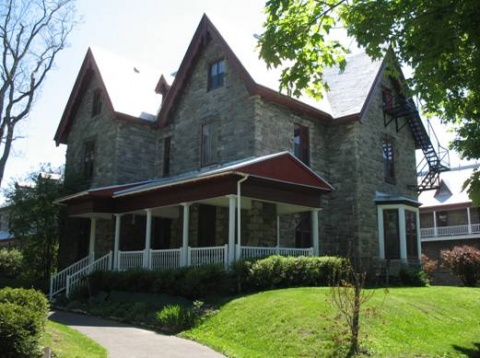
114 Richmond Rd - Ashcroft Homes Convent Development - additional information on application
You are here
I want to thank the nearly 100 residents who came out last night to hear and provide feedback on Ashcroft’s proposal to partially demolish the Soeurs de la Visitation convent at the Qwest development on Richmond Road. We’ve attached the plans below, let us know if you have any issues opening them.
In summary, the applicant is proposing to alter and demolish portions of the former convent and construct a glass addition. The north and east facades will be unchanged, but the three storey structure around the courtyard would be removed, with the new 4-storey structure replacing it. Office and restaurant uses are being proposed.
I share many of the concerns expressed by residents last night. There is still significant anger that the development was imposed on the community over its clearly expressed opposition. Its ultimate built form – the two condos facing Richmond Road – are frequently cited as an example of how not to do urban mainstreet development: a sterile and hostile canyon effect. Residents and I continue to decry the empty storefronts. The pedestrian path between Richmond and Byron is unmaintained in winter limiting its utility. Commitments made to the community to preserve the convent building and to put it to some significant community use have gone unmet.
With the developer’s language still fuzzy over what it means by “community” use, and little indication of a plan to fill those retail spaces and eliminate the dead zone on our main street, there is simply no goodwill in the community toward this latest proposal. My encouragement to staff and colleagues will be to refuse the application. Ashcroft has the permissions required to build a substantial second phase of its development. It should proceed according to the approvals it has, and not seek our buy-in to modifications to those approvals without a adopting a very new approach in its relationship with us based on establishing trust and following through on promises.
It will undoubtedly be expensive for Ashcroft to preserve the whole convent, and to turn it in some significant way to services and amenities that deliver on the promise of community use. But, it purchased a heritage building with eyes wide open. It is not residents’ obligation to accede to a proposal being made to deliver profits.
At last night’s meeting, a very good question was posed about how the heritage application will be considered by staff and Council. In many respects, this process will resemble that with which we are familiar in the ward. The building is designated a heritage building under the province’s Heritage Act. It can’t be altered or modified in any of its designated characteristics without Council’s approval. Ashcroft has applied for that approval. That doesn’t require the kind of consultation we’re used to in a re-zoning, but I’m passing any feedback I receive to planners and the developer – please keep sending it. In the meantime, staff will prepare a report making a recommendation to the Built Heritage Sub-committee to either approve or reject it. The sub-committee’s recommendation will then go to Planning Committee, and then to Council for subsequent votes. It’s important to note that Built Heritage Sub-committee, chaired by Councillor Nussbaum, also has non-Council members. I’ve observed them to be thoughtful in their task.
To help residents navigate this process – the first request for a heritage alteration or demolition that I can remember in the ward – I’ve attached some material.
The actual convent designation report is available here. It describes the attributes that have been protected and why. To see how staff will consider the application, it might be useful to look at the debate over moving the Bradley/Craig barn in Stittsville. Below, I’ve attached the staff report that recommended refusal of that application with their reasons why, as well as the cultural heritage impact statement that is the supporting material for an application like this. In that process, Council ultimately overturned staff’s refusal recommendation, but I think the supporting material will help residents understand the criteria that will be considered each step of the way, and how it differs from a planning application.
The Soeurs application will have a second component later. If they receive approval for the partial demolition, they will also then need planning approval for the expansion of the footprint on that site. Their current zoning approvals are “shrinkwrapped” – that is, they have a very specific footprint and building size that they can build. The original zoning actually still has a hold on it pending the submission of a site plan that meets the original zoning.
Another excellent question was posed last night that addresses this chicken-and-egg situation. Should the developer get the approval for the expansion of this building first, then apply for the heritage alteration? Or, the other way around?
I am comfortable that the key issue at play here is whether or not to allow the demolition. If Council won’t extend that permission, there is no point to applying for the modified zoning. There will still be a debate to come, if Ashcroft gets the required permission, on that re-zoning, which will follow the procedures with which we are familiar.
On a final note, it’s been important to me since the beginning of the term of Council that our public meetings played out in front of the TV cameras be respectful and civil. I want to thank residents who came out last night for their focused and constructive comments and feedback.
Below, please find the renderings provided by Ashcroft for your consideration and feedback. I welcome your comments, and will be sharing anything I receive both with the developer and staff in the hope that Ashcroft will take those into account before this finally goes before the sub-committee on March 8.
- Log in to post comments

